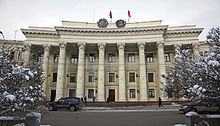Volgograd Region (Волгогра́дская о́бласть)
|
|
Volgograd Oblast (Russian: Волгогра́дская о́бласть, Volgogradskaya oblast) is a federal subject (an oblast) of Russia, located in the Volga region of Southern Russia. Its administrative center is Volgograd. The population of the oblast was 2,610,161 in the 2010 Census. Formerly known as Stalingrad Oblast, it was given its present name in 1961, when the city of Stalingrad was renamed Volgograd as part of de-Stalinization. Volgograd Oblast borders Rostov Oblast in the southwest, Voronezh Oblast in the northwest, Saratov Oblast in the north, Astrakhan Oblast and the Republic of Kalmykia in the southeast, and has an international border with Kazakhstan in the east. The two main rivers in European Russia, the Don and the Volga, run through the oblast and are connected by the Volga–Don Canal. Volgograd Oblast's strategic waterways have made it a popular route for shipping and for the generation of hydroelectricity. Volgograd Oblast is best known as the primary site of the Battle of Stalingrad during World War II, often regarded as one of the single largest and the bloodiest battle in the history of warfare. Geography
Volgograd Oblast borders with Saratov, Rostov, Astrakhan, and Voronezh Oblasts, as well as with Kalmykia of Russia and with Kazakhstan (West Kazakhstan Region). Volgograd has more than 200 rivers and streams. The major ones include:
HistoryStalingrad Oblast (Сталинградская область) was established on December 5, 1936 on the territory of former Stalingrad Krai. The oblast was given its present name on November 10, 1961. Politics
During the Soviet period, three people exercised oblast-level authority:
In 1991 the CPSU lost de facto power, and the head of the Oblast administration, and eventually the governor was appointed/elected alongside elected regional parliament. The Charter of Volgograd Oblast provides the fundamental law of the region. The Legislative Assembly of Volgograd Oblast is the province's standing legislative (representative) body. The Legislative Assembly exercises its authority by passing laws, resolutions, and other legal acts and by supervising the implementation and observance of the laws and other legal acts passed by it. The highest executive body, the Oblast Government, includes territorial executive bodies such as district administrations, committees, and commissions that facilitate development and run the day-to-day matters of the province. The Oblast administration supports the activities of the Governor, who is the highest official and acts as guarantor of the observance of the oblast Charter in accordance with the Constitution of Russia. DemographicsPopulation: 2,610,161 (2010 Census); 2,699,223 (2002 Census); 2,593,944 (1989 Census).
Settlements
|
|||||||||||||||||||||||||||||||||||||||||||||||||||||||||||||||||||||||||||||||||||||||||||||||||||||||||||||||||||||||||||||||||||||||||||||||||||||||||||||||||||||||||||||||||||||||||||||||||||
| Ethnic group | Population (in 2010) | Percent |
|---|---|---|
| Russians | 2,309,253 | 90 |
| Kazakhs | 46,223 | 1.8 |
| Ukrainians | 35,607 | 1.4 |
| Tatars | 24,557 | 0.9 |
| Armenians | 27,846 | 1.1 |
| Azerbaijani | 14,398 | 0.6 |
| Germans | 10,102 | 0.4 |
| Chechen | 9,649 | 0.4 |
| Belarusians | 7,868 | 0.4 |
- 44,541 people were registered from administrative databases, and could not declare an ethnicity. It is estimated that the proportion of ethnicities in this group is the same as that of the declared group.
Religion
| Religion in Oblast Krai as of 2012 (Sreda Arena Atlas) | ||||
|---|---|---|---|---|
| Russian Orthodoxy |
|
54.5% | ||
| Other Orthodox |
|
2.2% | ||
| Other Christians |
|
4.1% | ||
| Islam |
|
3.5% | ||
| Spiritual but not religious |
|
18.4% | ||
| Atheism and irreligion |
|
12.1% | ||
| Other and undeclared |
|
5.2% | ||
According to a 2012 survey 54.5% of the population of Volgograd Oblast adheres to the Russian Orthodox Church, 4% are unaffiliated generic Christians, 2% are Orthodox Christian believers who don't belong to any church or are members of non-Russian Orthodox churches, 3% are Muslims. In addition, 18% of the population declares to be "spiritual but not religious", 12% is atheist, and 6.5% follows other religions or did not give an answer to the question.
Government
Governor of Volgograd Oblast is Anatoliy Brovko (since 2010)
Both the flag and the coat of arms of Volgograd Oblast include an image of The Motherland Calls, an 85 meter tall statue located in Volgograd.
Economy
| Source: Wikipedia.org |










